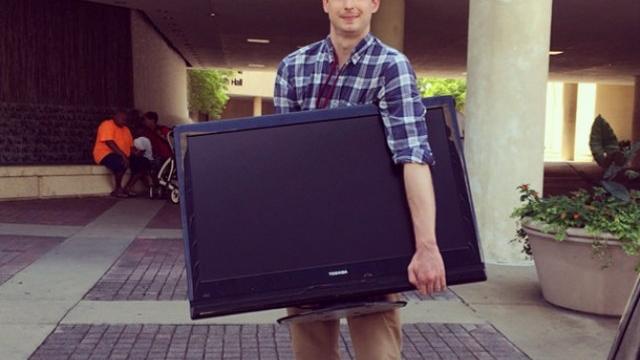In June, Antiques Roadshow visited Birmingham, Alabama, my home for the last three years. I don’t own a Tiffany lamp or a 19th century Chesterfield sofa. I do, though, have a flatscreen television that’s ancient by consumer electronics standards. So that’s what I brought to be appraised.
Full disclosure: I’d arranged to have my 2008 Toshiba flatscreen evaluated by a professional Antiques Roadshow-affiliated antiques czar a few weeks in advance. Which is good, both in that I wasn’t turned away at the door, and that I didn’t have to wait hours in line carting this monstrosity around:
The walk from the car to the convention centre floor was bad enough. (Image credit: my wife’s iPhone)
The unfortunate soul charged with evaluating my TV was Gary Piattoni. Gary’s been in the antiques business for years, splitting his time between electronics, militaria, furniture, and decorative arts. He’s sharp, dedicated and professional, which is why I’m even more astonished and appreciative that he went along with this dumb stunt.
It’s not like he didn’t have anything better to do. For those who aren’t familiar with Antiques Roadshow, it’s a massive undertaking, featuring dozens of antiques experts weighing in on thousands of collectibles ranging from the worthless to the well, guess I can retire now. The Birmingham spectacle alone saw multitudes of hopeful hoarders wending their way through hours and hours of convention centre lines, some of them toting objects so large they required elaborate contraptions to cart around. And that’s just one of the eight shows being taped this summer.
Not surprisingly, given the swell of esoterica, what makes the final televised cut is just a small fraction of total appraisals. Everything gets evaluated though, tiny dreams being crushed or realised at a frenetic pace throughout the weekend. All of it happens in a bullpen area, a wide circle of collapsible tables marked by antique category, staffed by experts like Gary, ready to appraise. The ones you ultimately see aren’t necessarily the most expensive items; they’re the ones with the most interesting backstories, the most surprising results, the most telegenic owners.
This wasn’t the Birmingham show, but the background gives you a sense of the set-up. Also, what a duck! (Image credit: AP/PBS)
That’s the area for people with a genuine interest in knowing the histories behind their very old objects. I took my dumb TV somewhere else.
The reason you’re not seeing a teeming mass of mahogany in the video above is that it was shot in a separate area for the web team, which was kind enough to both film and edit my Toshiba adventure. Once some crucial decisions were made — wipe off the smudges? nah, that’s patina — we were off.
Some words on the appraisal itself. We agreed going in to approach it like one would an actual antique, covering the same ground and asking similar questions. That required a bit of playing dumb, but also who wouldn’t want to know if their TV was the very first one? Also, in the heat of the moment, under the lights, I mistakenly said that I had originally paid $US600 for it. In retrospect, I think it was closer to $US900. Lastly, I was a little thrown by the idea of “connections for Playstation or Xbox”; in my mind I was picturing component cables (which I have plenty of jumbled up in a closet somewhere) but Gary was referring to inputs. We worked it out though!
We’ll be taking a closer look at how actual electronics collecting (it exists!) works in the coming weeks. But in the meantime I can say that the Antiques Roadshow experience is one that I can’t recommend highly enough, either as a collector or a viewer. Even for a product that doesn’t fit in with what’s typically on the show, the big reveal at the end gave me genuine flutters of joy and surprise. I can only imagine how magnified those feelings would be for items that have actual backstories — and price tags — worth unearthing.
Most technology ages poorly. Gary helped me confirm that. But a fascination with where objects come from — and how they ended up where they are today — has a timelessness you can’t put a price on.
